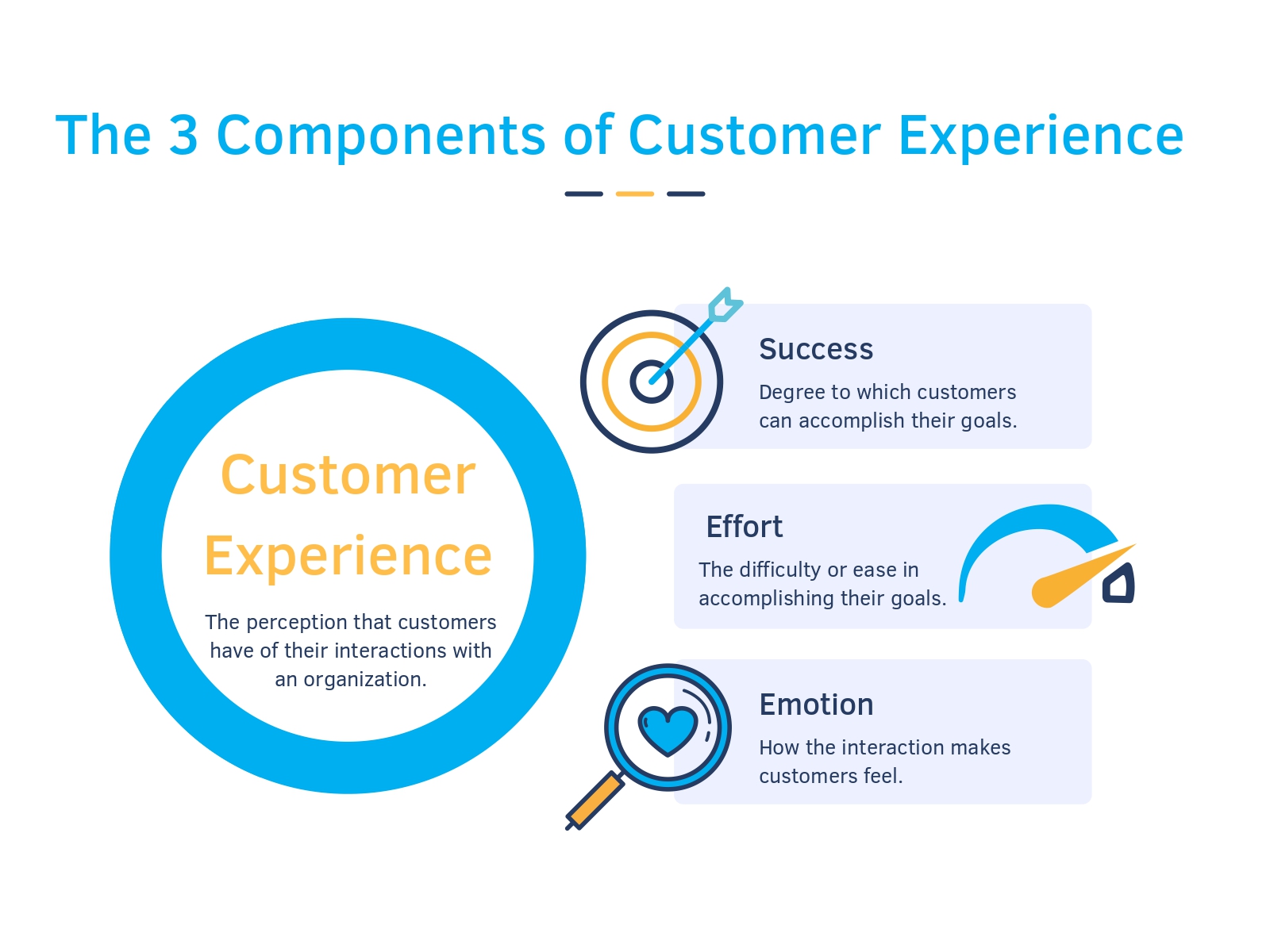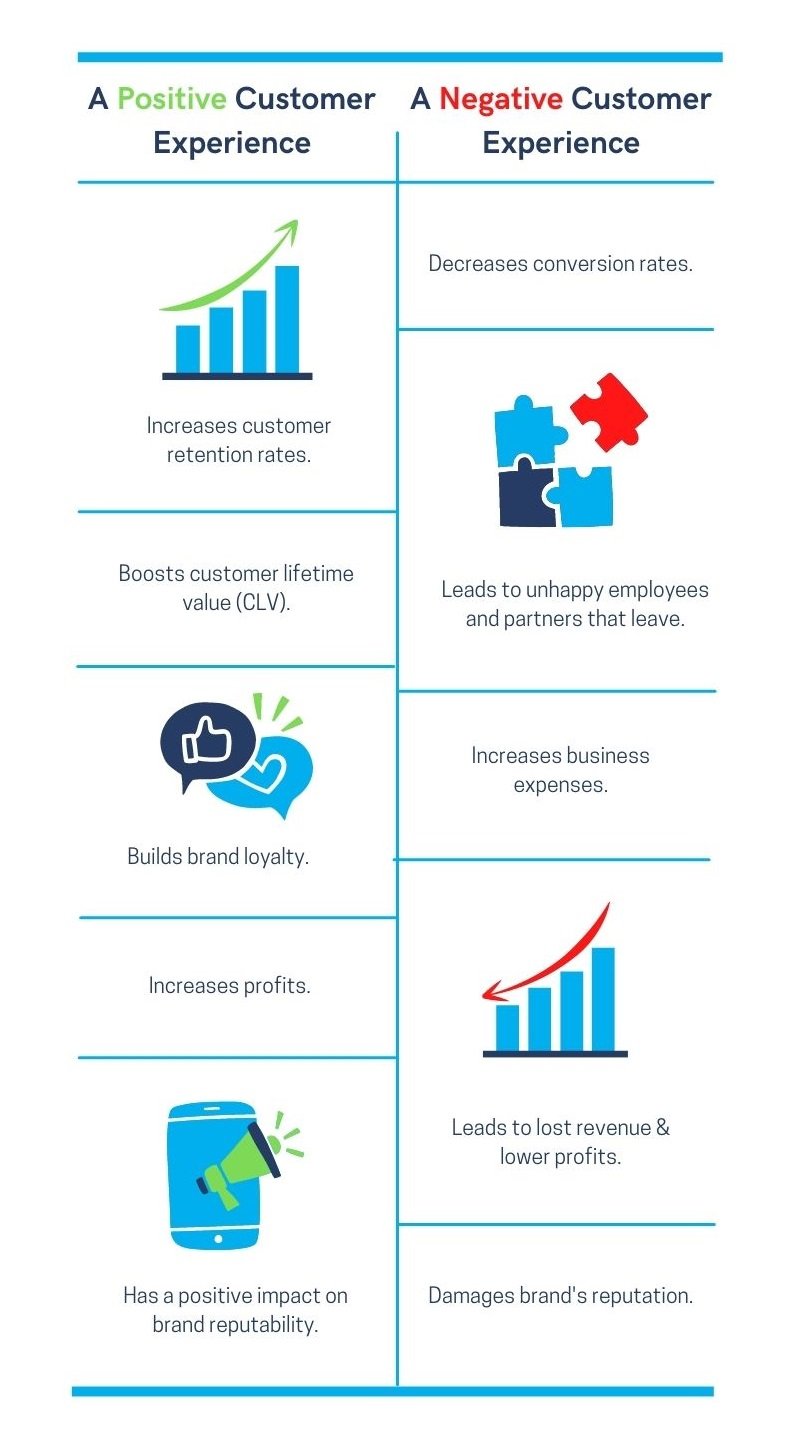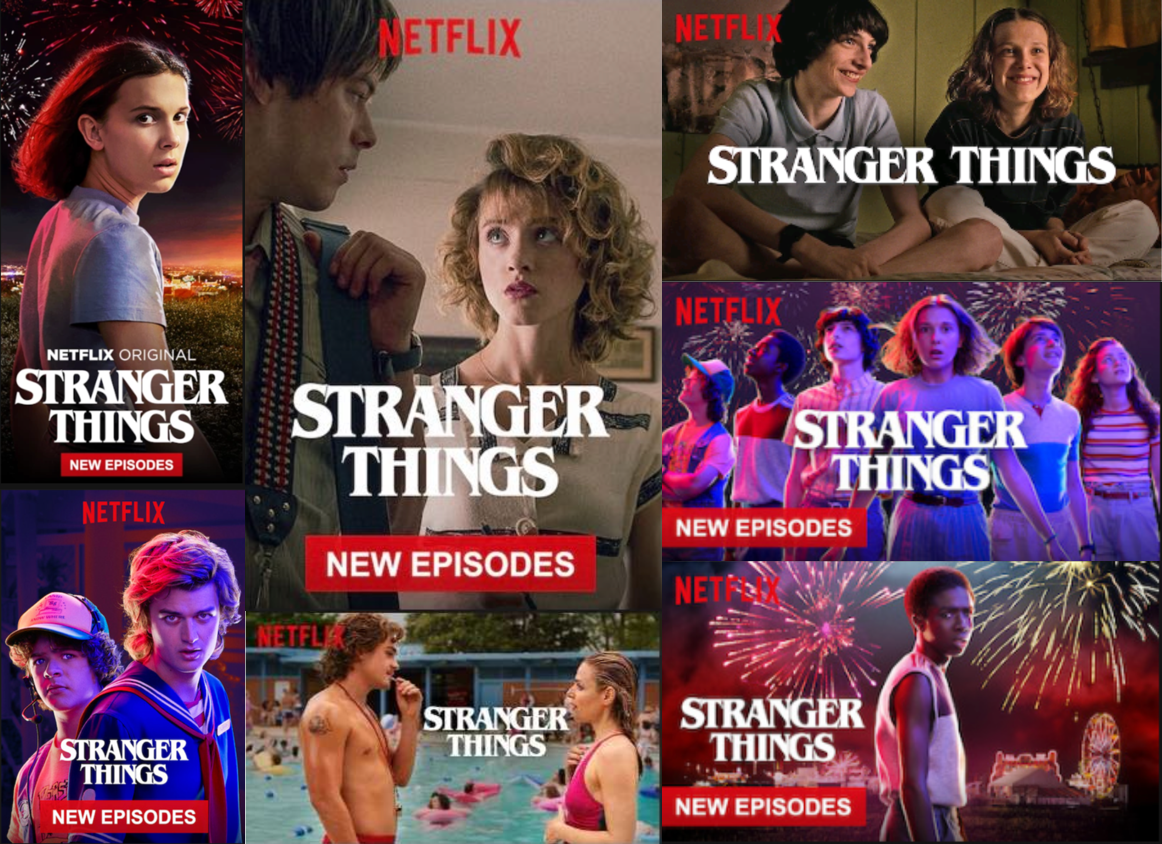Keeping your customers happy is key to your success as a business. This is why customer experience (CX) has been such a hot topic across sectors, even before the pandemic. Post-pandemic, CTOs and tech professionals delivering digital transformation plans will need to continue focusing on CX as a core business priority to ensure the adoption of revolutionary new technologies amongst the customer base.

A positive customer experience is the most effective way to increase customer satisfaction and engagement. In fact, numerous studies support that improving customer experience can have a significant impact on a brand's profitability, client retention and growth.
On the flip side, poor customer experiences create unhappy customers. And, did you know that unhappy customers are expensive?
Customers left with a bad taste in their mouth after interacting with your company or brand are more likely not to buy from you, now or in the future. Moreover, they can cause you reputational damage and loss of valuable referrals if they decide to share their experience with friends or broadcast it on social media. According to Forbes, dissatisfied customers translate into billions in lost revenue every year for brands worldwide. In financial terms, poor customer experience (CX) can have a measurable impact on your organisation's bottom line.
|
Why does Customer Experience Matter? What is the Definition of a Good Customer |
With this in mind, businesses today are increasingly recognising the power of a good customer experience when it comes to building loyalty, increasing retention and securing long-term growth. But what exactly is customer experience, and how do you make your CX better?
What is Customer Experience?
Consider every customer interaction with your business as a journey (a buyer's journey). Customer experience, also known as CX, is the holistic perception your customers have of your business or brand throughout this journey – from the awareness stage to the end of the customer lifecycle.
There are two primary touchpoints in a customer experience: the people and the products/services. However, every single aspect of the journey can affect the way your customers view and feel about your business. From the website navigation experience you offer to the quality of your customer services and your products' delivery time, everything you do can impact your customers' perception of you and their decision to keep coming back – or not.
According to Temkin, the "Godfather of Customer Experience", the key components of customer experience are the following three:
- Success: Was the customer's interaction successful? Were they able to accomplish their initial goals and/or fulfil their needs when they interacted with your business?
- Effort: Did the company make it easy for the customer to interact with them, and how much effort did the customer have to put forth?
- Emotion: How did the customer feel during and after the interaction? Were they upset or delighted after their experience with your company or brand?
 Of all three components, Emotion has the strongest impact on customers' overall impression of a company, their loyalty, and their likeness to purchase more, suggests Temkin.
Of all three components, Emotion has the strongest impact on customers' overall impression of a company, their loyalty, and their likeness to purchase more, suggests Temkin.
Explore the 10 Features of the Best Digital Transformations (Infographic)
Why does Customer Experience Matter?
Customer experience can make or break your business.
A positive customer experience can be the catalyst for a happy and loyal customer base, who are more likely to:
-
Spend More Money
A Harvard Business Review research identified a direct link between customer experience and annual revenue. Specifically, they found that customers with the best brand experience spent 140% more than those with a bad or less positive experience. Therefore, a satisfying brand experience can boost sales conversions and result in higher customer lifetime value (CLV).
-
Come Back for More
A superior experience boosts customers' satisfaction and encourages them to buy from your company multiple times. According to Qualtrics, leading companies in CX have customers who are 7x more likely to purchase more from them and 8x more likely to try additional products and services they sell. Hence, creating a good experience gives your business longevity and ensures that your customers will keep doing business with you in the future.
-
Stick with You for Life
Customers with a history of positive experiences with your products or services are more likely to become emotionally attached to your brand. Moreover, they will want to be associated with your business for a lifetime and will always choose you over your competitors. In numbers, a satisfied customer has a lifetime value of up to 10x more than a one-time customer. Simply put, happy customers stay loyal.
-
Become your Brand's Ambassadors
The best marketing a business can ask for is a customer who will promote its products and services through word-of-mouth, will recommend them to friends and family members, and advocate for them on social media. Happy customers can do that for you by sharing with the world those kinds of experiences that will generate a positive buzz around your brand.

On the other hand, negative customer experiences create unsatisfied and bitter clients. Some of the consequences of having an unhappy customer base include:
-
Tarnished Name and Reputation
The impact of unhappy customers extends well beyond your customer bubble. Dissatisfied customers tell twice as many people (between 9-15 people on average) about their negative experiences as happy customers do about their positive experiences. And they hardly ever tell you directly what went wrong or give you the chance to fix it. Instead, they complain to their social networks (friends, family, colleagues etc.), share their bad experiences with your brand on social media, and leave bad reviews online to prevent others from doing business with you.
-
Loss of Customers
More than 80% of customers stop doing business with a company after one bad customer experience. Poor CX disseminates a sentiment of neglect to customers, and when they don't feel valued or respected, they take their business elsewhere. But it's not only current customers that may be lost as a result of negative customer experiences. Potential customers may be discouraged from using a new product or service linked to a company with a bad reputation. Moreover, almost half of today's consumers won't consider interacting with a company or brand with mostly bad reviews and less than a four-star rating.
-
Loss of Profits
Poor CX is often the number one reason behind any reduction in the number of customers interacting with a business. And fewer customers means lower profits. Unhappy customers won't just stop doing business with you. They will turn to your competitors and encourage others to do the same. Less profit also means a limited budget to improve your customer experience strategy, hence, fewer chances of attracting future customers. To sum up, dissatisfied customers can drain your company's revenue and stability – and that's not an overstatement.
-
Loss of Potential Partners and Employees
A reputation for bad customer experiences can be enough to also discourage potential employees and other businesses from doing business with your company. After all, poor CX reflects a lack of care, and potential candidates and other partners will assume that if customers are not treated with sufficient respect and care, they won't be either.
-
Low Retention Rate
Dealing with customers on a daily basis is already challenging. But being subject to anger from dissatisfied customers is a heavy-duty not many are willing to undertake. Especially without sufficient strategies in place to resolve complaints, employees are far more likely to feel dissatisfied with their jobs. Eventually, unhappy employees, like customers, will choose to leave your company and seek employment elsewhere – probably in companies that provide effective customer service structures.
-
Increased Expenses
Companies with damaged reputations may see their spending increase in their attempt to restore some of the bruises, from expensive rebranding campaigns to new CX and marketing strategies. Moreover, the real cost of losing a customer due to poor customer experience is higher than you might think. There is not only the obvious economic loss a customer represents but also the hidden costs of replacing them. Studies have shown that acquiring a new client is 5x more expensive than keeping an existing customer.
The impacts of a positive vs negative customer experience at a glance:

What is the Definition of a Good Customer Experience?
A good customer experience makes it easy and pleasant for a customer to do business with you. It also helps customers accomplish their goals when interacting with your company or using your products and/or services. But most importantly, great CX makes your customers feel good during and after their journey with your brand.
These are some of the factors that constitute an exquisite customer experience:
- Personalized Interactions: A personalised approach is a must in enhancing customer satisfaction. According to Microsoft, 1/3 of people find the absence of a real person to solve their issues highly frustrating, leaving them with bad CX.
- Convenience: An environment that is easy to access and convenient to comprehend and use can greatly influence customer experience.
- Transparency: Being honest and authentic to your customers also means setting realistic expectations about your brand, products or services. This way, you can only exceed their expectations and never fail them.
- Responsiveness: Quick response time and always-available customer support reassure customers that you take them seriously and that their opinions, feedback or complaints are of great value to your company.
- User-Friendly Technology: Businesses that use advanced technologies can delve deeper into their customers' needs and expectations and – consequently – find innovative solutions to enhance the customer experience.
- Flawless Digital Interactions: From reaching your customers through their preferred channel to providing multi-lingual customer support, an easy-to-navigate and user-friendly website, simplified check-out options, multiple payment methods and everything in between can help you create a pleasant CX.
What's more important is that all these factors must work together to create a seamless, consistent and enhanced experience at every touchpoint of the customer's journey.
Take your business to the next level. Discover – How to Digitise A Company: 5 Most Successful Digital Transformations
5 Examples of Good Customer Experience
To further showcase why a good customer experience is vital for any business, we selected some of the best strategies implemented by industry giants. Let's dive into five notable CX examples and discover how famous brands are ensuring their audiences' loyalty and engagement:
-
Example #1: Amazon's Delivery Stations
Even with its current success, Amazon is constantly working to sharpen its shipping standards. Living up to its promise for fast delivery and minimal effort, the company is opening more than a thousand parcel-delivery stations in suburban U.S. locations to support local operations. This further narrows the gap between its fulfilment centres and shipping points and allows the online retail giant to enhance its unique selling point: same-day delivery. Amazon seems to know what its clients want and is not afraid to invest time and money into it.
-
Example #2: Apple's Community Hubs
Apple doesn't want to just sell innovative products and services – it is committed to turning itself into an "experience". The company's emerging store layouts are just a part of Apple's effort to become a central community hub that prompts face-to-face interactions and allows connections with customers on a personal level. Every store is a living and vibrant part of the community, where Apple experts meet with customers directly, offering a human face to the multi-trillion-dollar company.
-
Example #3: Burberry's AR Tool
In partnership with Google, Burberry has developed an Augmented Reality (AR) tool that takes advantage of Google's well-known data and geolocation advantages. The brand's online shoppers can now measure an outfit's size in real-time compared to other items or outfits in their immediate surroundings. The AR tool enhances the personalization of luxury retail, allowing customers to try on Burberry's product line from the privacy of their homes.
-
Example #4: Tesla's Outstanding Customer Service
Tesla's electric vehicles have been leading the way in revolutionizing the automotive industry. But, to make it happen, the company has had to take customer service to the next level. Knowing that what customers cherish the most is convenience, Tesla is offering its services directly to their homes. Whether it's a flat tire or an electrical gripe, Tesla's clients know that a team will arrive at their door to fix the issue within the day.
-
Example #5: Netflix's Customer-Focused Strategy
Netflix is primarily a data-driven company that uses complex internal algorithms to offer a personalized and unique customer experience to each Netflix user. As you might already know, when logged in, no two people see exactly the same streaming recommendations on their Netflix profile. What you might not know is that all of the thumbnails you see are also completely personalized to you as a viewer, based on what you have watched, clicked and searched.
 Some of the different thumbnails of Netflix's original show "Stranger Things".
Some of the different thumbnails of Netflix's original show "Stranger Things".
How to Improve Customer Experience
Your ultimate goal as a business should be to make your audience happy and convert them into loyal customers who can help you boost revenue. Here are seven tips to improve your customer experience:
-
Map your Customers' Journey
Before you start investing all your time and resources into a strategy you think might improve your customer experience, it's probably best to have an action plan in place. And in most cases, creating a customer journey map is a great place to start.
A customer journey map illustrates every step your customers take when interacting with your company. This includes engagements that extend well beyond the purchasing touchpoints, such as social media engagements, online advertising, and customer service interactions. Therefore, by mapping these interactions, you can abstract valuable insights into what's working and – most importantly – what's not working for them.
- How does each interaction influence the customer's perspective?
- What are your customer's needs and expectations?
- Which channels do your customers use the most?
- Are there any friction points across your customer's journey?
Once you have mapped out the journey for each type of customer, you will have the answers to these questions so you can better identify the gaps between the desired and your current performance as a business and refocus efforts on new areas of your customer experience that could stand improvement.
-
Develop an Omnichannel CX Strategy
An omnichannel strategy is extremely important for businesses to gain a deeper understanding of their customers and their behaviour throughout their lifecycle. That's because, with an omnichannel CX strategy, you don't just meet your customers where they are – that's only the cherry on top. By providing a consistent multichannel communication journey for your customers, you go a step further and ensure that their conversation history and context follow them flawlessly across all channels. And when it comes to delivering a good experience, context – like who your customer is, what emails they've opened, or what's in their shopping basket – is crucial.
Ultimately, an omnichannel CX strategy aims to provide a cohesive customer experience regardless of the channel (online or offline) through which your customers reach out to you. Here's what you can do to ensure a seamless customer journey:
- Make sure your website is mobile-friendly.
- Determine which channels your customers are using the most and choose to invest your time and marketing efforts there.
- Keep your content relevant to each marketing channel (for example, photos and videos do well on TikTok and Instagram, while longer text-based content works better on blog posts or newsletters).
- Provide cross-channel customer support, such as email support, social media messaging or phone calls.
- Invest in online and offline marketing tools, like easy-to-use email marketing software for personalised campaigns, customisable website builders, social media management software and in-store experiences for in-house clients.

-
Allow Customer Feedback to Lead the Way
No matter how well you think you know your customers, there will always be some drivers, needs or struggles in their journey that you won't be aware of – unless they tell you themselves.
Customer feedback is a very powerful tool if used properly. That's why the most successful companies base everything they do, from product creation to marketing initiatives, on the feedback they gather from their customers.
Feedback from customers can give insight into customers' expectations, as well as how they might change over time as your industry changes. Furthermore, you can find out where customers get stuck and what works well. Customer feedback is also the best way to pinpoint and acknowledge the issues you have as a business, so you can then do your best to address them. Moreover, listening to your customers and acting on their feedback help build trust and reassure them that you value and respect their opinions.
Here are some of the most effective ways to encourage and collect your customers' feedback:
- Customer feedback surveys
- Email and customer contact forms
- Usability tests
- Customer interviews
- Social media platforms
-
Deliver Superior Customer Service
Customers choose to do business with you not just because your product or service meets their needs. They choose you again and again because they feel confident they will receive the support they need when they need it. A great service experience leads customers to buy more and stay loyal to a brand for longer and can be a powerful differentiator from your competitors.
In other words, customer service is the foundation of every great customer experience, and there is data that proves it:
- A whopping 91% of customers say good service makes them more likely to purchase from a company again. (Salesforce)
- 89% of businesses now compete on the level of service they deliver to customers rather than just on their products and services. (Gartner)
- Customers who think a company has good service are 38% more likely to recommend that company to their network. (Qualtrics XM Institute)
Some ways to improve your customer service include:
- Having trained and supported employees with a view to growing customer service skills and behaviours.
- Delivering on quality, not just on speed and efficiency.
- Running your business on flexible, scalable, and easy-to-use infrastructure.
- Offering multiple channels for support as part of your omnichannel approach.
- Optimizing delivery and response times.
- Using benchmark metrics like Net Promoter Score (NPS) to make sure you are continually improving.
-
Personalise the Customer Journey
Personalisation has always been in trend. However, today's customers don't just seek personalised interactions; they demand them. According to Accenture, 1/3 of customers will abandon a brand if their experience isn't personalised enough.
Personalisation allows the experience to adapt for each customer based on what you know about them and empowers you to deliver the right content, at the right time, to the right person. Delivering personalised customer experiences is the key to making customers feel valued and creating strong bonds between your brand and customer.
Depending on the scale and scope of your company, personalisation can take on many forms, including:
- Sending personalised notes, gifts, or products to your customers.
- Offering loyalty schemes and money-off vouchers to your best buyers.
- Using data to personalise survey questions.
- Providing product recommendations based on past purchases or search history.
- Engaging with customers over their preferred contact method, account type, or status.
- Personalized online experiences, such as dynamic website content based on user preferences.
- Using geolocation technology to personalise your services based on location.
Creating customer personas and understanding your customers' preferences, personalities, habits, etc., can help you better target your personalisation efforts. Additionally, UX research on your business's support initiatives can also be used to make customer interactions more personalised.
Note: Today, personalisation is a digital transformation journey in which you can embark modestly (with automated personalised emails, for example) or deep dive right into AI- and data-driven personalisation. The choice is yours, but you can't afford to miss the boat.

Discover the 5 Best Tech Tools to Deliver a Successful Digital Transformation
-
Leverage the Power of Artificial Intelligence
According to Gartner, 70% of customer interactions today involve an emerging technology such as machine-learning applications, chatbots or mobile messaging.
Industry-leading companies are quickly adapting by leveraging the power of emerging technologies like AI to improve customer experiences and achieve faster growth. For instance, more and more businesses are deploying AI-powered chatbots and virtual assistants to improve their customer service and increase engagement.
A chatbot can save businesses up to 30% on customer support costs, speed up response times, and answer up to 80% of FAQs. Moreover, bots are the best way to address customer requests in real-time and reduce customer frustrations from being on hold or queuing.
Other ways to enhance CX with AI tech include:
- Auto-responses to routine customer queries when your support team is busy or not available.
- Customer service interactions run by AI which give you time to focus on more complex issues.
- Customer base segmentation and increased personalisation. By collecting user data from every touchpoint, AI can auto-send personalised messages and even track responses.
-
Invest in the Right Tech, Tools and People
According to an Oracle survey, 2/3 of companies today use at least one advanced technology for CX, and almost half of those who use AI reported an increase in sales per customer.
Undoubtedly, in the era of digital, it's not easy to create breakthrough customer experiences without the right technology and tools. From chatbots that are there for customers around the clock to natural language processing which allows you to understand free-form text messages and machine learning that creates tailor-made CX experiences, the latest digital technology has made time-to-insights faster and personalisation more scalable and affordable. And there's more:
- Next-generation digital tools allow you to engage customers across multiple channels and automate workflows.
- Automated messages help you increase customer engagement and deliver faster support.
- With predictive analytics, you can reduce churn and find solutions to complicated problems.
- Customer data platforms (CDPs) allow you to build unified customer profiles.
- With testing and optimisation tools in hand, you can get creative with your products.
- Digital and voice assistants provide new ways for customers to interact with you.
- AI and related tech allow you to offer more personalised interactions.
To drive true customer experience transformation, however, you would also need the right people – skilled and committed tech professionals that will support your business and your efforts to improve customer experience.
Are you in search of top tech talent?
We can help – Templeton has over 26 years of experience recruiting thousands of skilled IT professionals across 40 countries. Find out more about our multi-award-winning recruitment services.
Do you know What are the Most Important Skills Needed for Digital Transformation?




